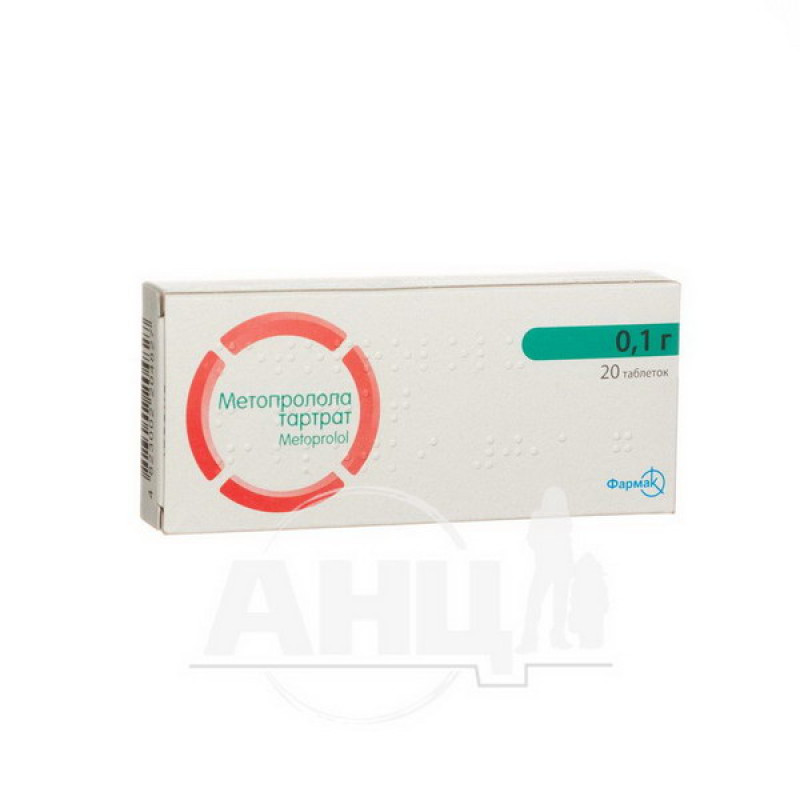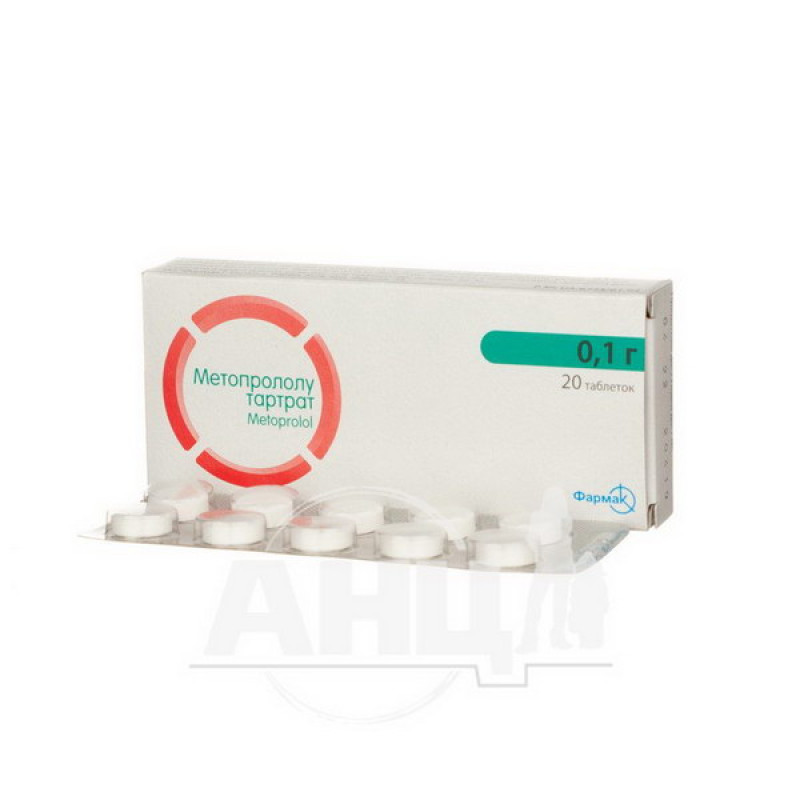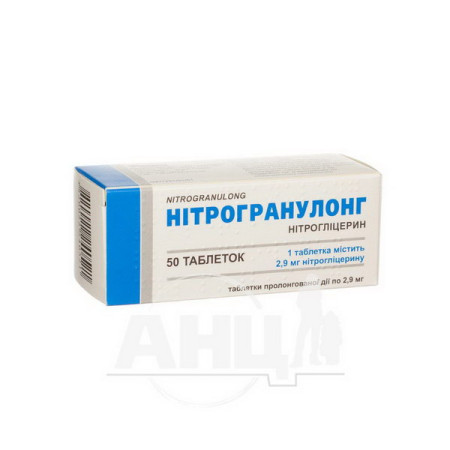Metoprolol tartrate tablets 0.1 g blister No. 20

Pharmacological properties
Pharmacodynamics. Metoprolol tartrate is a cardioselective β-adrenoceptor blocker without intrinsic sympathomimetic activity and membrane-stabilizing action. It acts mainly on β1-adrenoceptors of the heart, has antianginal, hypotensive and antiarrhythmic effects. In patients who have had myocardial infarction, it reduces the risk of recurrent myocardial infarction, and in patients with AG - it also reduces the risk of cardiovascular complications (stroke). Its antiischemic effect has been proven in the case of painless myocardial ischemia and a decrease in left ventricular hypertrophy in patients with AG.
The antianginal effect is due to a decrease in heart rate, myocardial contractility, systemic blood pressure, which leads to a decrease in myocardial oxygen demand. Due to the prolongation of diastole (due to the negative chronotropic effect), myocardial perfusion improves. Unlike non-selective β-adrenoceptor blockers, Metoprolol tartrate when used in medium therapeutic doses has a less pronounced effect on the smooth muscles of the bronchi and peripheral arteries, insulin release, carbohydrate and lipid metabolism.
Pharmacokinetics. After oral administration, the absorption of Metoprolol tartrate in the gastrointestinal tract is almost complete (90%) and does not depend on food intake, but the bioavailability is about 50% due to intensive metabolism during the first passage through the liver (65-80%). With prolonged use, bioavailability increases due to a decrease in blood circulation in the liver and saturation of liver enzymes. C max of the drug in blood plasma is recorded after 1-2 hours, but the effect on blood pressure and heart rate is observed (after a single dose of 100 mg) for 12 hours.
T ½ - 3-7 hours. In renal failure it increases to 27 hours or more. Excreted by the kidneys in the form of metabolites. In hepatic failure the drug can accumulate in the body. It penetrates well through the blood-brain barrier, the placental barrier and into breast milk. Smoking, alcohol consumption, the use of certain drugs change the metabolism of Metoprolol tartrate (for example, barbiturates, diphenin, rifampicin - increase, chlorpromazine - reduce). Biotransformation in the liver is reduced in cirrhosis, so the dose is reduced in these patients, and the concentration in the blood plasma is controlled.
Indication
Ag, angina pectoris (including post-infarction); arrhythmia (including supraventricular tachycardia); prevention of cardiac death and recurrent infarction after the acute phase of myocardial infarction. as part of complex therapy for thyrotoxicosis. prevention of migraine attacks.
Application
The dose of metoprolol tartrate is set individually. The maximum daily dose is 400 mg.
The tablets are taken orally with a small amount of liquid, without chewing, after meals.
The duration of the treatment course is determined individually and can be 3 years.
In hypertension, the initial dose is 100 mg once a day or divided into 2 doses (morning and evening). If necessary, the daily dose can be increased to 200 mg.
For angina pectoris, 50-100 mg of Metoprolol tartrate is prescribed 2-3 times a day.
For arrhythmia, 50 mg is prescribed 2-3 times a day. If necessary, the daily dose can be increased to 300 mg, divided into 2-3 doses.
In hyperthyroidism (thyrotoxicosis), 50 mg is prescribed 4 times a day. When the therapeutic effect is achieved, the dose is gradually reduced.
In myocardial infarction (it is advisable to start treatment within the first 12 hours after the onset of chest pain): 50 mg every 6 hours for 48 hours, maintaining the recommended daily dose of 200 mg, divided into 2 doses. The course of treatment is at least 3 months.
Prevention of migraine attacks: Metoprolol tartrate is prescribed at a dose of 100-200 mg/day, divided into 2 doses.
Dosage adjustment is necessary in patients with impaired liver function.
Elderly people and patients with renal insufficiency do not require dose adjustment.
Contraindication
Hypersensitivity to metoprolol, other β-adrenergic blockers or other components of the drug. AV blockade II and III degree, cardiogenic shock; heart failure in the stage of decompensation (pulmonary edema, hypoperfusion syndrome or hypotension); prolonged or intermittent inotropic therapy with β-receptor agonists; clinically significant sinus bradycardia; sick sinus syndrome; severe arterial hypotension, metabolic acidosis; severe peripheral circulatory disorders; history of BA or bronchospasm; severe liver failure; severe peripheral vascular disease with the threat of gangrene, untreated pheochromocytoma.
The drug should not be prescribed to patients with suspected acute myocardial infarction with a heart rate of 45 beats / min, a PQ interval of 0.24 or with a systolic blood pressure of 100 mm Hg.
Side effects
From the side of the central nervous system: dizziness, headache, depression, sleep disturbances (nightmares), insomnia, mood changes, short-term memory impairment, a feeling of numbness of the skin and "creeping", a feeling of cold in the extremities, confusion, hallucinations, increased excitability, nervousness, anxiety, impaired concentration, personality disorders.
Gastrointestinal tract: dyspeptic phenomena (nausea, vomiting, diarrhea, constipation), heartburn, abdominal pain, flatulence, dry mouth, retroperitoneal fibrosis (a clear causal relationship between this reaction and taking metoprolol has not been established).
On the part of the respiratory system: some patients may experience shortness of breath during physical exertion, cough, bronchospasm, attacks of bronchial asthma (in patients with bronchial asthma), rhinitis.
From the cardiovascular system: arterial hypotension, slowing of the pulse, AV-blockade II and III degree, slowing of AV-conduction, worsening of symptoms of heart failure, pain in the heart area, palpitations, bradycardia, increased frequency of angina attacks, cardiogenic shock in patients with acute myocardial infarction, edema, Raynaud's syndrome, arrhythmia, possible exacerbation of existing peripheral circulatory disorders (up to gangrene), exacerbation of symptoms of intermittent claudication.
On the part of the sense organs: decreased vision, conjunctivitis, decreased secretion of tear fluid (this circumstance should be taken into account by patients who wear contact lenses), decreased hearing (tinnitus).
Allergic reactions: itching, skin rashes (in most cases - psoriasiform or dystrophic skin lesions), urticaria, hair loss, skin photosensitization, exacerbation of psoriasis.
On the part of the endocrine system: hypoglycemia may develop in patients with diabetes.
From the hematopoietic system: thrombocytopenia, leukopenia, agranulocytosis.
Changes in laboratory parameters: increased activity of liver enzymes, hyperbilirubinemia, increased TG levels in the blood, decreased HDL levels, appearance of antinuclear antibodies (not associated with systemic lupus erythematosus).
Others: increased fatigue, increased sweating, nonspecific pain in muscles and joints, muscle spasms, cramps, arthritis, weight gain, libido disorders, impotence, Peyronie's disease (a clear causal relationship between this reaction and taking metoprolol tartrate has not been established).
Special instructions
When using metoprolol tartrate, as with other β-adrenergic blockers, it is necessary to monitor heart rate and blood pressure (initially daily, then once a month).
Patients taking β-adrenergic blockers should not receive intravenous verapamil.
Particularly careful medical supervision is necessary in the treatment of patients with diabetes mellitus (blood glucose control), patients with unstable blood sugar levels, when following a strict fasting diet. In rare cases, manifestation of latent diabetes or worsening of the condition of patients with diabetes mellitus is possible. When treated with metoprolol, the risk of affecting carbohydrate metabolism or the risk of developing latent hypoglycemia is less than when using non-selective β-adrenoceptor blockers.
Metoprolol tartrate may mask some clinical manifestations of thyrotoxicosis (e.g. tachycardia). Abrupt withdrawal of the drug in patients with thyrotoxicosis is contraindicated due to possible exacerbation of symptoms.
Patients with pheochromocytoma treated with Metoprolol tartrate should be simultaneously prescribed α-adrenoblockers.
Before performing surgical interventions, it is necessary to warn the anesthesiologist about taking metoprolol tartrate. Discontinuation of treatment is not recommended.
It is necessary to stop treatment with the drug gradually, reducing the dose within 10 days to 25 mg. With sudden withdrawal of the drug, withdrawal syndrome may occur (increased angina attacks, increased blood pressure).
At a heart rate of 50-55 beats/min, the dose of the drug should be reduced or gradually discontinued.
If necessary, the drug should be prescribed to patients with asthma, it may be necessary to increase the dose of β2-adrenergic stimulators.
When using metoprolol tartrate, the severity of allergic reactions may be increased and adrenaline in usual doses may be ineffective. Anaphylactic shock in patients taking β-adrenergic blockers is severe.
Patients who wear contact lenses should be aware that the drug may reduce tear secretion.
The drug should be used with caution in patients with myasthenia gravis, depression, vasospastic angina, chronic diseases of the bronchopulmonary system, psoriasis, Raynaud's disease; in the elderly (monitor kidney function).
Patients with angina require special monitoring. Metoprolol should be prescribed with particular caution to patients with Prinzmetal's angina.
Metoprolol may lead to exacerbation of peripheral arterial disease, such as intermittent claudication.
Special attention should be paid to patients with severe renal impairment, with serious acute conditions accompanied by metabolic acidosis, and patients receiving combination treatment with digitalis preparations.
Use during pregnancy or breastfeeding. During pregnancy (especially in the first trimester), Metoprolol tartrate should be used only if there are vital indications, when the expected therapeutic effect outweighs the potential risk to the fetus. Due to the possible development of bradycardia, hypotension, hypoglycemia and respiratory depression in the newborn, the course of treatment should be interrupted 48-72 hours before delivery. The amount of metoprolol tartrate that the child can receive with breast milk is unlikely to lead to β-blocking effects if the mother takes the drug in usual therapeutic doses. However, caution should be exercised when prescribing β-adrenoceptor blockers to breastfeeding mothers, and the child should be observed for timely detection of β-blocking effects.
Children. The use of Metoprolol tartrate in children is contraindicated.
Ability to influence the reaction rate when driving vehicles or working with other mechanisms. During treatment with the drug, it is necessary to refrain from driving vehicles or working with other potentially dangerous mechanisms.
Interactions
When metoprolol tartrate is taken simultaneously with insulin or oral hypoglycemic agents, their effect may be enhanced or prolonged. In this case, the symptoms of hypoglycemia (especially tachycardia and tremor) may be masked or disappear. In such cases, regular monitoring of blood glucose levels is necessary.
Metoprolol is a substrate of the enzyme CYP 2D6. The plasma concentration of metoprolol may be affected by drugs that are inhibitors of CYP 2D6, such as quinidine, terbinafine, paroxetine, fluoxetine, sertraline, celecoxib, propafenone and diphenhydramine. At the beginning of treatment with these drugs, a dose reduction of Metoprolol tartrate may be necessary.
Concomitant use of Metoprolol tartrate with the following drugs should be avoided:
Barbituric acid derivatives: barbiturates (studied for pentobarbital) stimulate the metabolism of metoprolol by enzyme induction.
Propafenone: In four patients treated with metoprolol, plasma concentrations of metoprolol increased 2-5-fold after administration of propafenone, and two patients experienced side effects typical of metoprolol. The interaction was confirmed in eight healthy volunteers. This interaction is probably due to the fact that propafenone, like quinidine, inhibits the metabolism of metoprolol via the cytochrome P450 2D6 system. The outcome of this combination is unpredictable, since propafenone also has β-blocking properties.
Verapamil: in combination with β-adrenergic blockers (described for atenolol, propranolol and pindolol) verapamil may cause bradycardia and a decrease in blood pressure. Verapamil and β-adrenergic blockers have an additive inhibitory effect on AV conduction and sinus node function.
Concomitant use of Metoprolol tartrate with the following drugs may require dose adjustment:
Amiodarone: Patients taking amiodarone may develop marked sinus bradycardia when co-administered with metoprolol. Amiodarone has an extremely long T½ (approximately 50 days), which means that the interaction may occur long after discontinuation of this drug.
Class I antiarrhythmics: Class I antiarrhythmics and β-blockers have additive negative inotropic effects, which may lead to serious hemodynamic side effects in patients with impaired left ventricular function. This combination should also be avoided in patients with sick sinus syndrome and AV conduction disorders. This interaction is best described for disopyramide.
NSAIDs and antirheumatic drugs: NSAIDs have been shown to interfere with the antihypertensive effect of β-adrenergic blockers. Indomethacin has been most commonly studied. This interaction is unlikely to occur with sulindac. A negative interaction study has been conducted with diclofenac.
Digitalis glycosides: Concomitant use of digitalis glycosides and β-adrenergic blockers may increase AV conduction time and cause bradycardia.
Diphenhydramine: Diphenhydramine reduces (by 2.5-fold) the clearance of metoprolol to α-hydroxymetoprolol via the CYP 2D6 system in individuals with rapid hydroxylation. The effects of metoprolol are enhanced. It is possible that diphenhydramine may inhibit the metabolism of other CYP 2D6 substrates.
Diltiazem: Diltiazem and β-adrenergic blockers have additive inhibitory effects on AV conduction and sinus node function. Marked bradycardia has been reported with diltiazem.
Phenylpropanolamine: Phenylpropanolamine in a single dose of 50 mg can cause a pathological increase in diastolic blood pressure in healthy volunteers. Propranolol generally prevents the increase in blood pressure by phenylpropanolamine. However, β-blockers can provoke paradoxical hypertensive reactions in patients taking phenylpropanolamine in high doses. In two cases, hypertensive crisis during monotherapy with phenylpropanolamine has been described.
Quinidine: inhibits the metabolism of metoprolol in extensive metabolizers with a significant increase in plasma levels and, as a result, increased β-adrenergic blockade. A similar interaction is possible with other β-adrenergic blocking agents that are metabolized by the same enzyme (cytochrome P450 2D6).
Clonidines: β-adrenergic blockers may potentiate the hypertensive reaction upon abrupt withdrawal of clonidine. If it is necessary to discontinue combination therapy with clonidine, the β-adrenergic blocker should be discontinued several days prior to clonidine withdrawal.
Nitroglycerin: simultaneous administration may lead to severe hypotension.
Rifampicin: Rifampicin may induce the metabolism of metoprolol, leading to a decrease in its plasma levels.
Patients who are taking other β-adrenergic blockers (e.g. in the form of eye drops) or MAO inhibitors simultaneously with Metoprolol tartrate should be carefully monitored. The administration of inhalation anesthetics to patients receiving treatment with β-adrenergic blockers increases the cardiodepressive effect. The concentration of metoprolol in the blood plasma may increase with the simultaneous administration of cimetidine or hydralazine.
Overdose
Symptoms: bradycardia, AV block I-III degree, prolongation of the QT interval, asystole, decreased heart rate, insufficient peripheral perfusion, heart failure, cardiogenic shock, bronchospasm, respiratory depression, respiratory arrest, fatigue, confusion, loss of consciousness, fine tremor, convulsions, increased sweating, paresthesia, nausea, vomiting, esophageal spasm, hypoglycemia (especially in children) or hyperglycemia, effects on the kidneys, transient myasthenic syndrome. Simultaneous use of alcohol, antihypertensive drugs, quinidine or barbiturates may worsen the patient's condition. The first signs of overdose are possible 20 minutes to 2 hours after taking the drug.
Treatment: general detoxification measures are carried out (gastric lavage, taking activated charcoal and laxatives).
NB! Atropine (0.25-0.5 mg IV for adults, 10-20 mcg/kg body weight for children) should be administered before gastric lavage (due to the risk of vagal stimulation). Intubation and use of a mechanical ventilation device may be required; adequate restoration of BCC; glucose infusion; ECG monitoring; repeated IV administration of atropine 1-2 mg (mainly for vagal symptoms). In case of myocardial depression: infusion of dobutamine or dopamine and calcium glubionate 9 mg/ml, 10-20 ml. Glucagon 50-150 mcg/kg IV over 1 min with subsequent infusion, as well as amrinone, can be administered. In some cases, the addition of adrenaline has been effective. Sodium (chloride or bicarbonate) infusion with QRS complex prolongation and arrhythmia. A pacemaker can be used. In case of circulatory arrest, resuscitation measures may be necessary for several hours. In case of bronchospasm, terbutaline (injection or inhalation) is prescribed. Symptomatic therapy.
Storage conditions
In a place protected from light at a temperature not exceeding 25 °C.
There are no reviews for this product.
There are no reviews for this product, be the first to leave your review.
No questions about this product, be the first and ask your question.








